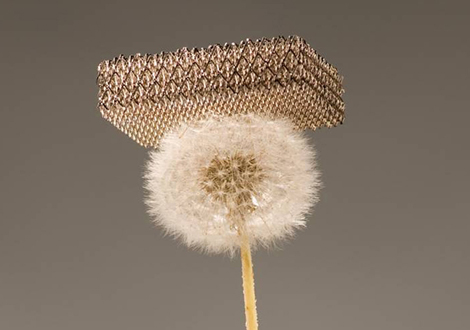Lighter Than a Feather

Crunchy as it appears, the structure above is no chocolate wafer resting atop a dandelion. It is metallic micro-lattice, newly christened the world’s lightest material. Created for DARPA by HRL Laboratories in collaboration with researchers at the California Institute of Technology and the University of California, this material is so light that it can balance on dandelion fluff without crushing it. However, don’t be deceived by its size or weight, as materials can actually get stronger when shrunk to nanoscale.
The micro-lattice’s shape is in part inspired by the strong, lightweight architecture of structures like the Eiffel Tower and the Golden Gate Bridge. The lattice is made by passing ultraviolet light through a photomask which constructs the frame of the lattice from a photo-sensitive polymer. Using this method, the tubes are created with a diameter of only 100 to 500 micrometers. The lattice is then coated with nickel using a technique called electroless plating. After the lattice is coated with the nickel, the polymer is dissolved leaving only hollow tubes of nickel about 100 times thinner than a human hair. The final result is a metallic structure that is 100 times lighter than Styrofoam and, amazingly, 99.99% air by volume.
Watch as the lattice is compressed and regains its shape in this slow-motion video:
Why does this all matter? At the moment, researchers are speculating that metallic micro-lattice could be used as shock absorbers, increasing your safety in a car and anywhere else you might need to be cushioned from harm. After the lattice is crushed, it decompresses and regains up to 98% of its original shape (see the video above for a demonstration). But that’s not all this super-light material can do: it could also potentially be used in battery electrodes, and its mostly-air composition makes it a great thermal insulator. Best of all, there will surely be many more, unforeseen applications for metallic micro-lattice to come – you just need to dream them up!
This has been a guest post by Sebastian Kazenbroot-Guppy, Dallas Leclerc, and Wayne Ho, students at the University of British Columbia
Image by Dan Little from HRL Laboratories, LLC – via Wikipedia
Filed under: e-News, Materials
Tags: Materials, Nanotechnology








